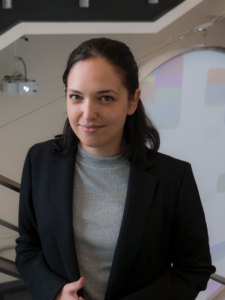 The following Great Innovative Idea is from Orit Peleg an Assistant Professor of Computer Science from the University of Colorado Boulder. Peleg was one of the participants at the recent Computing Community Consortium (CCC) Robotic Materials workshop.
The following Great Innovative Idea is from Orit Peleg an Assistant Professor of Computer Science from the University of Colorado Boulder. Peleg was one of the participants at the recent Computing Community Consortium (CCC) Robotic Materials workshop.
The Idea
Animals use a combination of egocentric navigation driven by the internal integration of environmental cues, interspersed with geocentric course correction and reorientation. These processes are accompanied by uncertainty in sensory acquisition of information, planning, and execution. Together with L. Mahadevan (Harvard University) and M. Dacke (Lund University), we consider the question of optimal reorientation rates for the navigation of an agent moving along a preferred direction in the presence of multiple sources of noise. This is inspired by observations of dung beetle navigational strategies that show switching between geocentric and egocentric strategies [1].
We address this using a model that takes the form of a correlated random walk at short time scales that is punctuated by reorientation events leading to a biased random walks at long time scales [2]. This allows us to identify optimal alternation schemes and characterize their robustness in the context of noisy sensory acquisition as well as performance errors linked with variations in environmental conditions and agent–environment interactions.
Impact
Our study might well be generalizable more broadly to animal navigation, and perhaps artificial vehicular navigational situations, all of which use egocentric and geocentric cues with varying attention to create optimal strategies that balance accuracy and efficiency in the presence of noise, and additional constraints such as finite cognitive bandwidth. A natural next step would be to test the theory with animals, e.g. dung beetles, as well as autonomous robotic agents.
Other Research
Through several diverse projects, my lab harnesses the power of computational tools to answer fundamental questions in biology and ecology. In particular, we focus on how organisms adapt to environmental fluctuations. A major area of research concerns honeybee clusters as we dissect how bees create a stable structure in the presence of mechanical stress. We also investigate signaling between animals, specifically, the methods animals employ to amplify and interpret signals across large space and time scales. To solve this problem, my lab uses honeybees, plants, and fireflies as model organisms.
Researcher’s Background
My background is multidisciplinary; I received a B.S. in physics and computer science and an M.S. in physics from Bar-Ilan University in Israel. I completed my Ph.D. in material science at ETH Zurich, where I began modeling competitive interactions in biophysical systems. I used computational techniques to study a wide range of protein interactions, from fibronectin chains and fibers to the dynamic behavior of actin filaments. During postdoctoral work at Harvard University, I became invested in a broad range of biophysics research. I began investigating order and disorder in protein evolution, which progressed to an interest in the organization of larger biological materials, e.g., insect swarms.
Links
[2] O.Peleg, L. Mahadevan. Optimal switching between geocentric and egocentric strategies in navigation. R. Soc. Open Sci., 3, 160128 (2016)
To view more Great Innovative Ideas, please click here.









